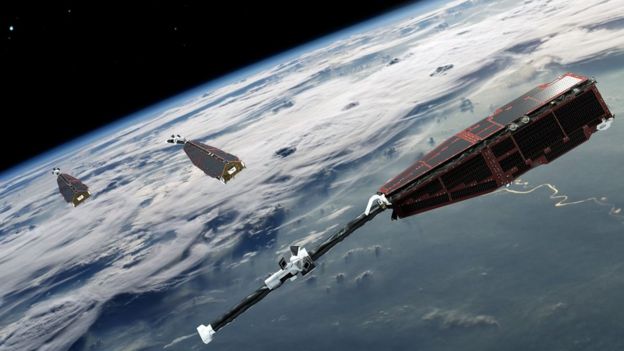Swarm satellites launched in 2013 by ESA (European Space Agency) in order to study the magnetic data from Earth’s crust, mantle, ionosphere, core, oceans, and magnetosphere. Data collected by satellites presented interesting info.

Image Courtesy of ESA
Data analysis discovered that a Jetstream of molten iron is running within the Earth’s core; the stream is 420 km wide and it is flowing westwards at an average speed of 40 km per year. The research details are published in a research paper – “An accelerating high-latitude jet in Earth’s core” – published in Nature Geoscience.
Lead researcher Phil Livermore of the University of Leeds said: “They are providing our sharpest x-ray image yet of the core. We’ve not only seen this jet stream clearly for the first time, but we understand why it’s there,” comparing the stream of molten iron with jet streams in the Earth’s atmosphere.

The core was studied via data from the planet’s magnetic field since the core itself is 3,000 km deep and we can’t just observe it. The jet stream of molten iron is moving at speeds that can surpass 50 km per hour, which is a thousand times faster than the speed with which tectonic plates move. The molten river is flowing westwards, passing under Alaska and Siberia, and it can be the cause for the pockets of concentrated magnetic fields that can be found in the northern hemisphere.
The iron river is accelerating, “This jet of liquid iron is moving at about fifty kilometers per year,” said Chris Finlay of Denmark’s National Space Institute at the Technical University of Denmark. The reason for acceleration is still unknown, but it is known that the river in the Earth’s core trebled its speed since 2000. Rune Floberghagen, ESA’s Swarm mission manager, noted that “Further surprises are likely. The magnetic field is forever changing, and this could even make the jet stream switch direction.”
The satellites could uncover why the Earth’s magnetic field has weakened in recent times, with some scientists believing the North and The South Pole may have started switching places. Another discovery by the swarm satellites is an answer explaining GPS blackouts in low-orbit GPS satellites. It seems blackouts are caused by huge thunderstorms, happening in the ionosphere.
